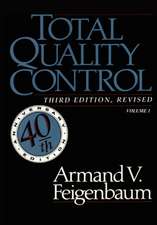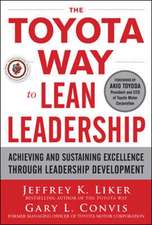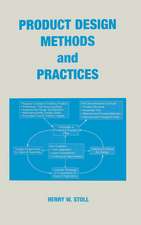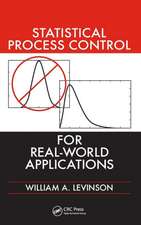Lean Six SIGMA for the Office: Analysis and Understanding: Series on Resource Management
Autor James William Martinen Limba Engleză Hardback – 8 sep 2008
The author brings experience gleaned from his application of these methodologies in a myriad of industries to create a practical and hands-on reference for the office environment. Using a detailed sequence of activities, including over 140 figures and tables as well as checklists and evaluation tools, he demonstrates how to realize the rapid improvement of office operations, and how to eliminate unnecessary tasks through value stream mapping (VSM).
The book also emphasizes the importance of strategic alignment of Kaizen events and the impact of organizational culture on process improvement activities. Latter chapters in the book discuss key elements of a change model in the context of transitional improvements as they relate to the process owner and local work team. By applying the proven principles found in this book, effective and sustainable organizational change can be accomplished, efficiency can be improved, and mistakes can be eliminated.
| Toate formatele și edițiile | Preț | Express |
|---|---|---|
| Hardback (2) | 388.45 lei 22-36 zile | +28.77 lei 5-11 zile |
| Taylor & Francis – 23 mar 2021 | 388.45 lei 22-36 zile | +28.77 lei 5-11 zile |
| CRC Press – 8 sep 2008 | 426.94 lei 43-57 zile |
Preț: 426.94 lei
Preț vechi: 464.07 lei
-8% Nou
Puncte Express: 640
Preț estimativ în valută:
81.69€ • 85.52$ • 67.60£
81.69€ • 85.52$ • 67.60£
Carte tipărită la comandă
Livrare economică 07-21 aprilie
Preluare comenzi: 021 569.72.76
Specificații
ISBN-13: 9781420068795
ISBN-10: 1420068792
Pagini: 362
Ilustrații: 100 black & white illustrations, 460 black & white tables
Dimensiuni: 157 x 236 x 23 mm
Greutate: 0.64 kg
Ediția:New.
Editura: CRC Press
Seria Series on Resource Management
ISBN-10: 1420068792
Pagini: 362
Ilustrații: 100 black & white illustrations, 460 black & white tables
Dimensiuni: 157 x 236 x 23 mm
Greutate: 0.64 kg
Ediția:New.
Editura: CRC Press
Seria Series on Resource Management
Public țintă
Business and operations management.Cuprins
I. Step 1: Align Improvement Opportunities
Strategy Alignment
What Is Kaizen?
Strategic Alignment
General Deployment Strategies
Reducing System Complexity
Outsourcing Processes
How to Deploy Lean in Three Steps
Important Elements of a Lean System
Project Identification
Lean Supply Chain
Conducting a Lean Assessment
Breaking Down High-Level Goals and Objectives
Project Identification—Process Analysis
Typical Project Examples
Key Metric Definitions
Project Charter Example
Prioritizing Projects
Lean Six Sigma Basics
Understand the Voice of the Customer (VOC)
Create Robust Product and Process Designs to Reduce Complexity
Deploy Lean Six Sigma Teams
Performance Measurements
Create Value Stream Maps (VSMs)
Eliminate Unnecessary Operations
Implement Just-in-Time (JIT) Systems
Supplier Networks and Support
Implement Visual Control and Pull Systems—Kanban
Continually Update Process Technologies
II. Step 2: Plan and Conduct the Kaizen Event
Kaizen Event Planning
Prepare for the Kaizen Event
Kaizen Event Communication Letter
Kaizen Event Kickoff Agenda
Conducting the Event
Evaluate the Kaizen Event
Data Collection and Analysis
Value Stream Mapping
Brown-Paper Exercise
Process Characterization
Simple Analysis of Process Data
Process Mapping—SIPOC
Cause-and-Effect (C&E) Diagrams
Five-Why Analysis
Histogram
Pareto Chart
Box Plot
Scatter Plot
Time Series Graph
Control Charts
Example: Analyzing Job Shadowing Data
Example: Inventory Analysis and Reduction
Process Improvement
Common Process Changes
Control Tool Effectiveness and Sustainability
Root Cause Analysis and Improvement Strategies
Examples Using Common Process Workflows
Identifying and Prioritizing Improvement Opportunities
III. Step 3: Implementing Solutions
Building a Business Case for Change
Change Readiness
Project Transition
Building a Business Case for Change
CostߝBenefit Analysis
Key Stakeholder Analysis
Infrastructure Analysis
Scheduling Process Change Activities
Communication
Implementing Solutions
Key Questions
Control Plan Requirements
Important Control Tools
Statistical Process Controls
Measurement System Improvements
Failure Mode and Effects Analysis (FMEA)
Other Control Tools
Quality Control Plan
Communicating the Proposed Changes to Management
Follow-Up Activities
Creating Metric Dashboards
Reinforcing New Behaviors and Organizational Change
Process Change across Global Supply Chains
Conclusion
Appendix 1: Crystal Ball® Software
Appendix 2: Minitab® Statistical Software and Quality Companion
by Minitab
Appendix 3: Figures and Tables
Glossary
Index
Strategy Alignment
What Is Kaizen?
Strategic Alignment
General Deployment Strategies
Reducing System Complexity
Outsourcing Processes
How to Deploy Lean in Three Steps
Important Elements of a Lean System
Project Identification
Lean Supply Chain
Conducting a Lean Assessment
Breaking Down High-Level Goals and Objectives
Project Identification—Process Analysis
Typical Project Examples
Key Metric Definitions
Project Charter Example
Prioritizing Projects
Lean Six Sigma Basics
Understand the Voice of the Customer (VOC)
Create Robust Product and Process Designs to Reduce Complexity
Deploy Lean Six Sigma Teams
Performance Measurements
Create Value Stream Maps (VSMs)
Eliminate Unnecessary Operations
Implement Just-in-Time (JIT) Systems
Supplier Networks and Support
Implement Visual Control and Pull Systems—Kanban
Continually Update Process Technologies
II. Step 2: Plan and Conduct the Kaizen Event
Kaizen Event Planning
Prepare for the Kaizen Event
Kaizen Event Communication Letter
Kaizen Event Kickoff Agenda
Conducting the Event
Evaluate the Kaizen Event
Data Collection and Analysis
Value Stream Mapping
Brown-Paper Exercise
Process Characterization
Simple Analysis of Process Data
Process Mapping—SIPOC
Cause-and-Effect (C&E) Diagrams
Five-Why Analysis
Histogram
Pareto Chart
Box Plot
Scatter Plot
Time Series Graph
Control Charts
Example: Analyzing Job Shadowing Data
Example: Inventory Analysis and Reduction
Process Improvement
Common Process Changes
Control Tool Effectiveness and Sustainability
Root Cause Analysis and Improvement Strategies
Examples Using Common Process Workflows
Identifying and Prioritizing Improvement Opportunities
III. Step 3: Implementing Solutions
Building a Business Case for Change
Change Readiness
Project Transition
Building a Business Case for Change
CostߝBenefit Analysis
Key Stakeholder Analysis
Infrastructure Analysis
Scheduling Process Change Activities
Communication
Implementing Solutions
Key Questions
Control Plan Requirements
Important Control Tools
Statistical Process Controls
Measurement System Improvements
Failure Mode and Effects Analysis (FMEA)
Other Control Tools
Quality Control Plan
Communicating the Proposed Changes to Management
Follow-Up Activities
Creating Metric Dashboards
Reinforcing New Behaviors and Organizational Change
Process Change across Global Supply Chains
Conclusion
Appendix 1: Crystal Ball® Software
Appendix 2: Minitab® Statistical Software and Quality Companion
by Minitab
Appendix 3: Figures and Tables
Glossary
Index
Descriere
Six Sigma guru Martin presents proven modifications that can be deployed in offices, particularly those offices involved with global operations. Making use of Kaizen and Six Sigma concepts, along with Lean manufacturing principles, this book instructs managers on how they can improve operational efficiency and increase customer satisfaction.
Notă biografică
James William Martin is a Lean Six Sigma consultant and Master Black
Belt for 25 years and has trained and mentored several thousand executives,
champions, Black Belts, and Green Belts in process improvement methods
including manufacturing, services, and supply chain applications. He
led successful Lean Six Sigma assessments across Japan, China, Korea,
Singapore, Malaysia, Th ailand, Australia, North America, and Europe. Th is
work included organizations in hardware, soft ware, computer security,
retail sales, banking, insurance, fi nancial services, measurement systems,
automotive, electronics, aerospace component manufacturing, electronic
manufacturing, controls, building products, industrial equipment, and
consumer products. He served as an instructor at the Providence College
Graduate School of Business for 20 years. He holds an MS in Mechanical
Engineering, Northeastern University; an MBA, Providence College; a BS,
Industrial Engineering, University of Rhode Island; several patents; and he
has written numerous articles on process improvement.
Belt for 25 years and has trained and mentored several thousand executives,
champions, Black Belts, and Green Belts in process improvement methods
including manufacturing, services, and supply chain applications. He
led successful Lean Six Sigma assessments across Japan, China, Korea,
Singapore, Malaysia, Th ailand, Australia, North America, and Europe. Th is
work included organizations in hardware, soft ware, computer security,
retail sales, banking, insurance, fi nancial services, measurement systems,
automotive, electronics, aerospace component manufacturing, electronic
manufacturing, controls, building products, industrial equipment, and
consumer products. He served as an instructor at the Providence College
Graduate School of Business for 20 years. He holds an MS in Mechanical
Engineering, Northeastern University; an MBA, Providence College; a BS,
Industrial Engineering, University of Rhode Island; several patents; and he
has written numerous articles on process improvement.




















